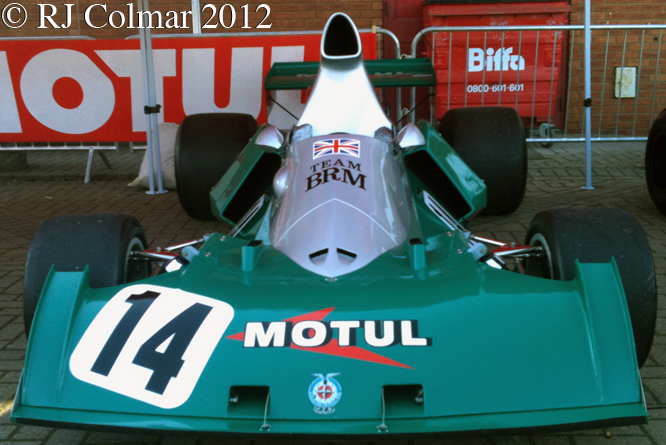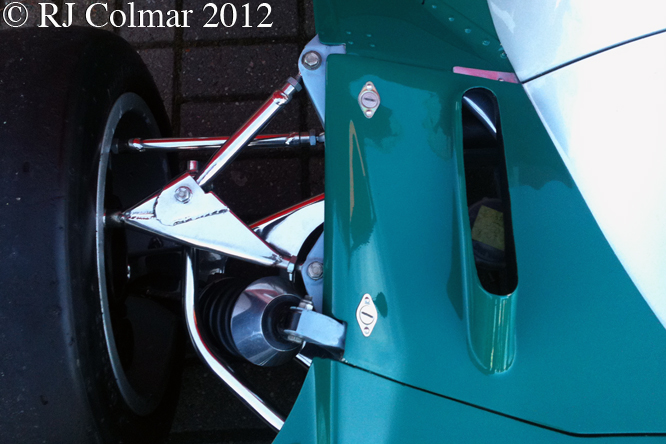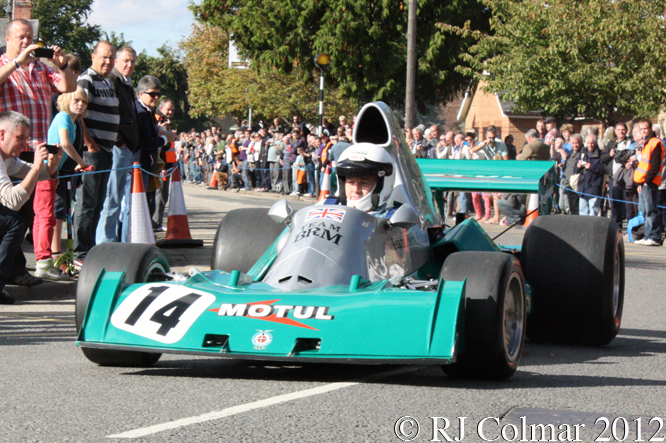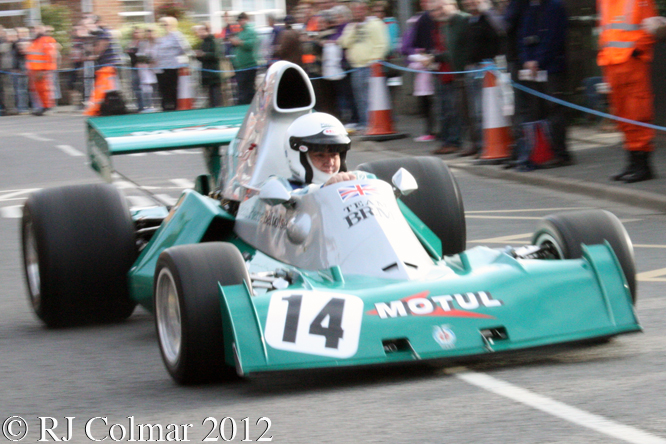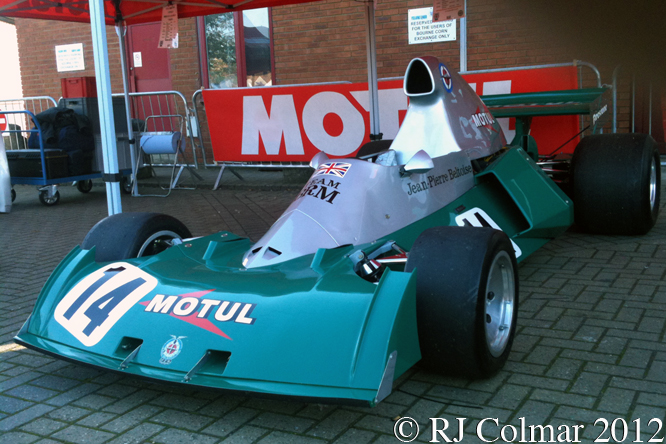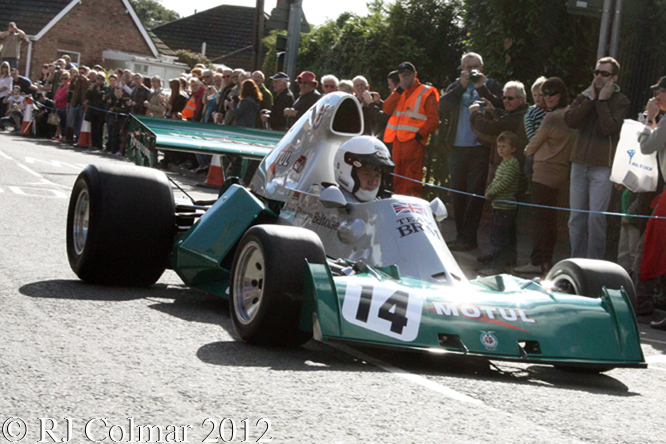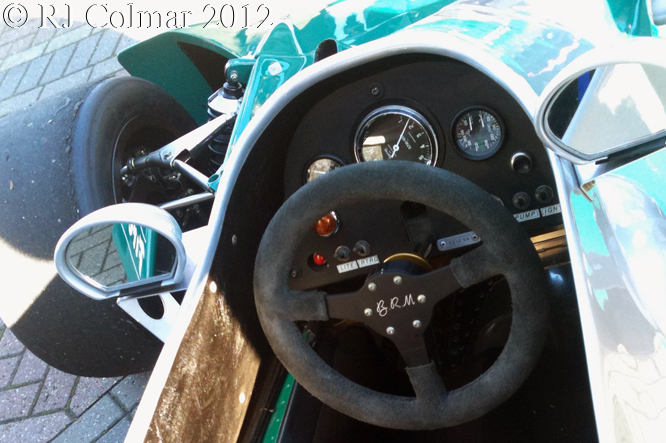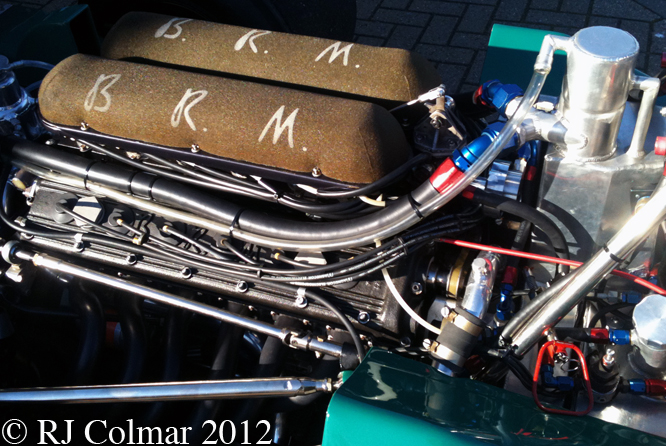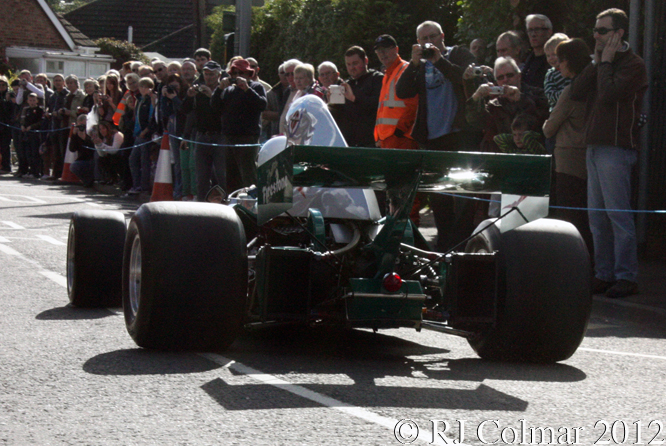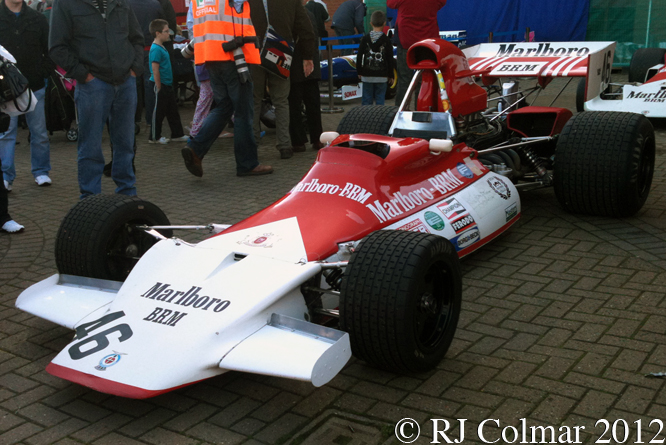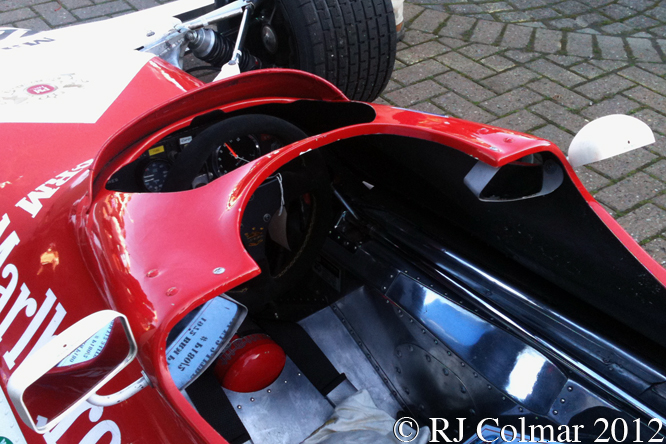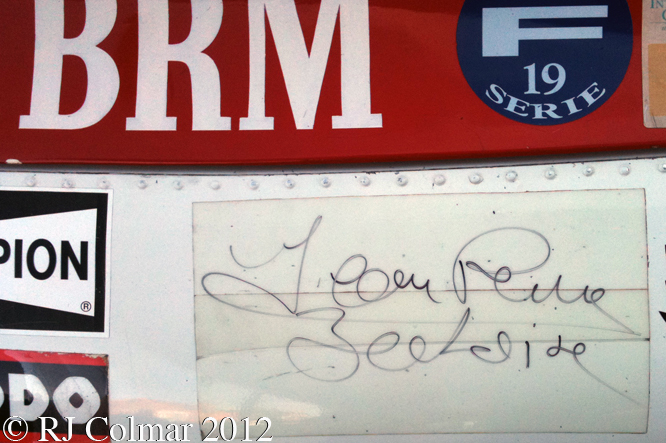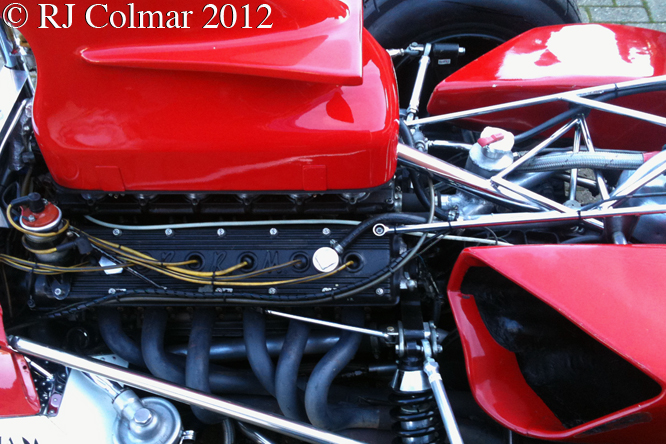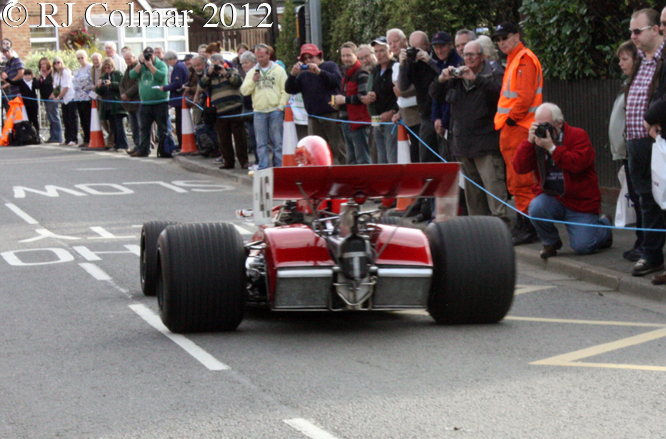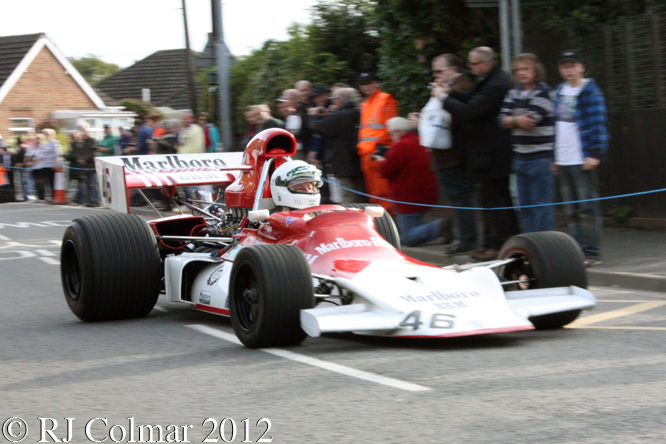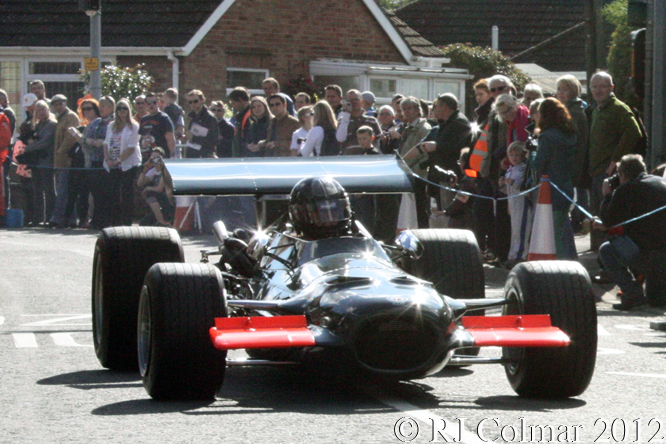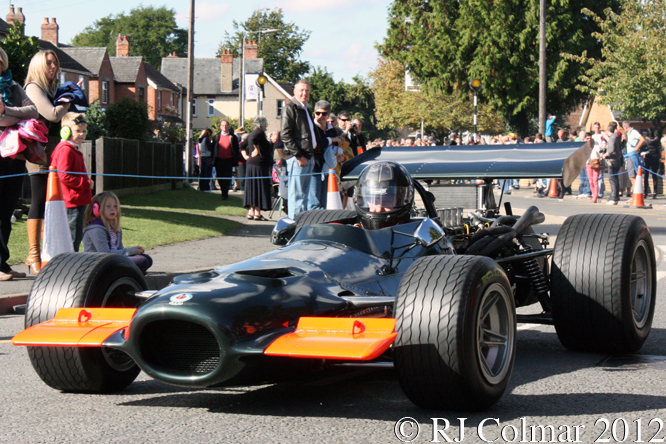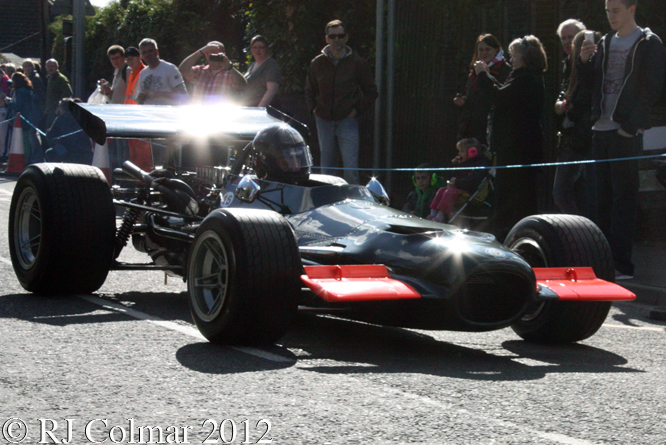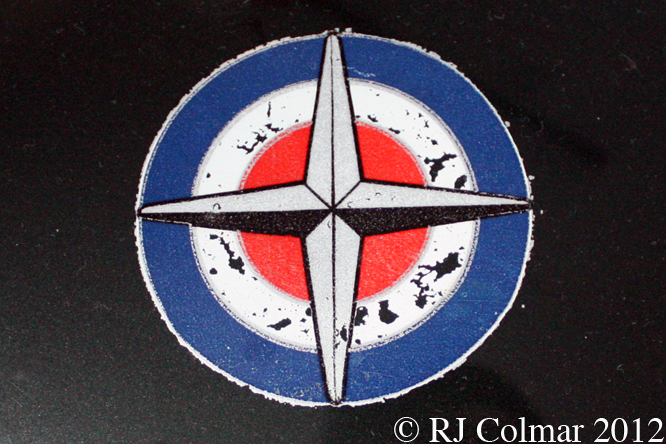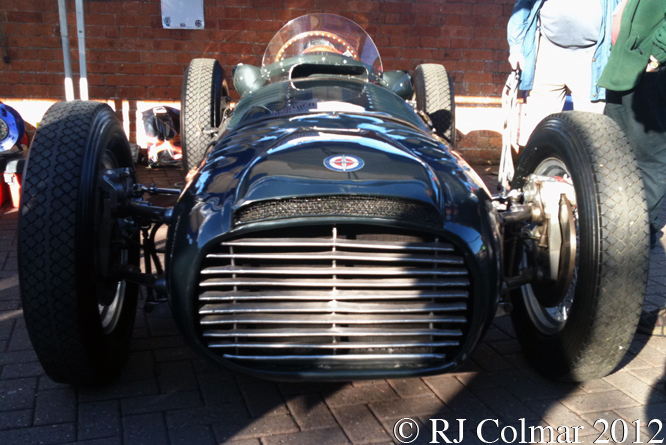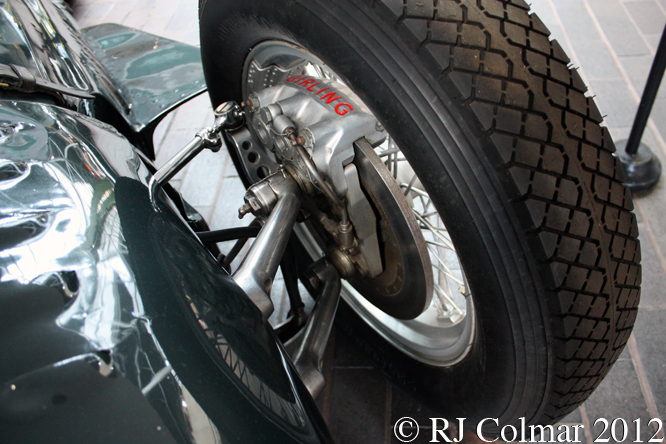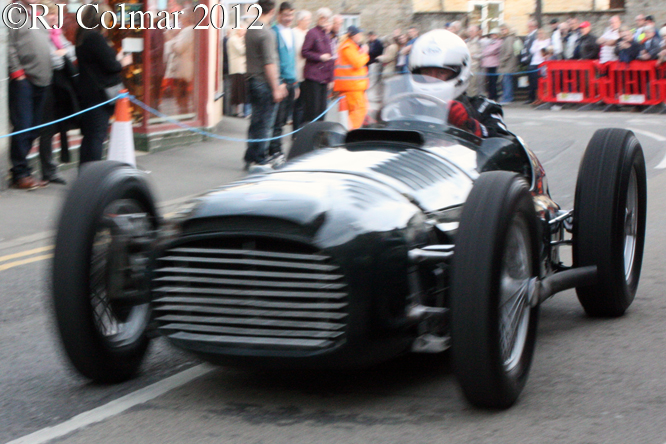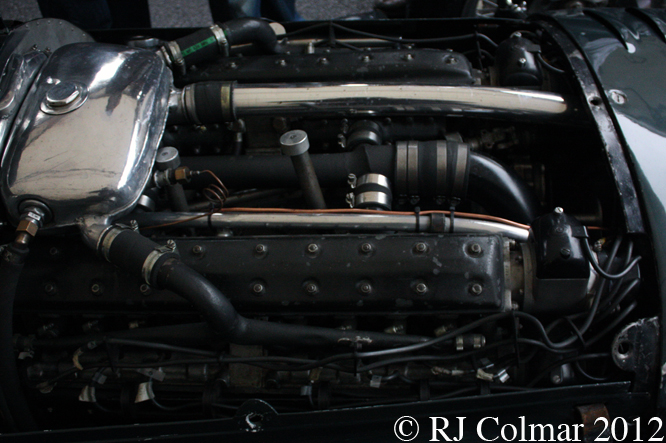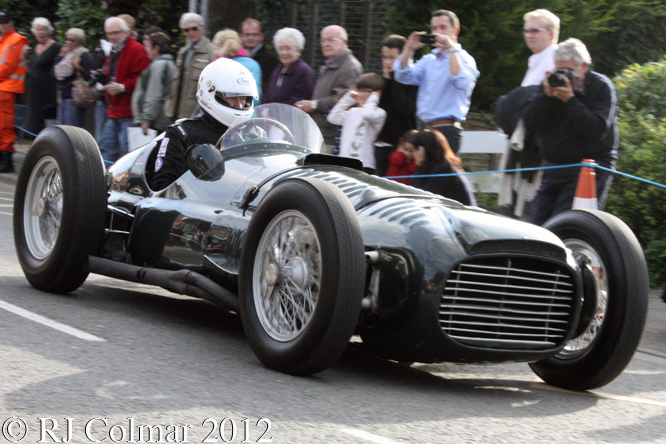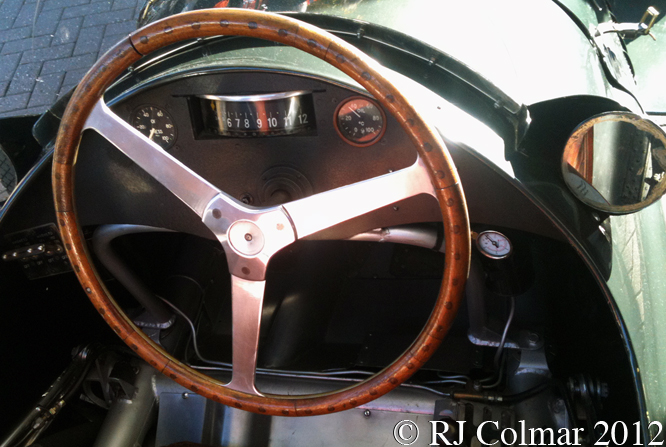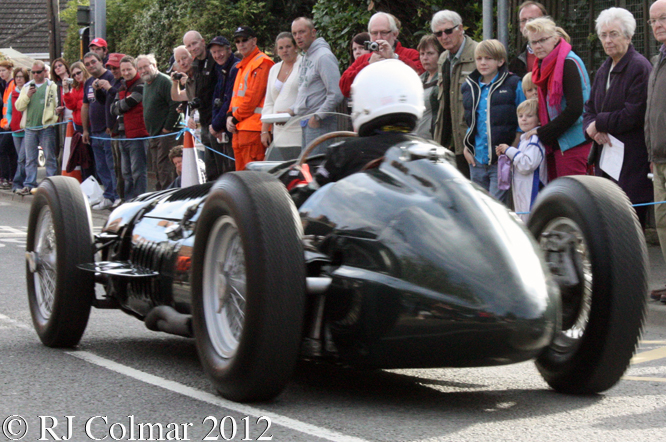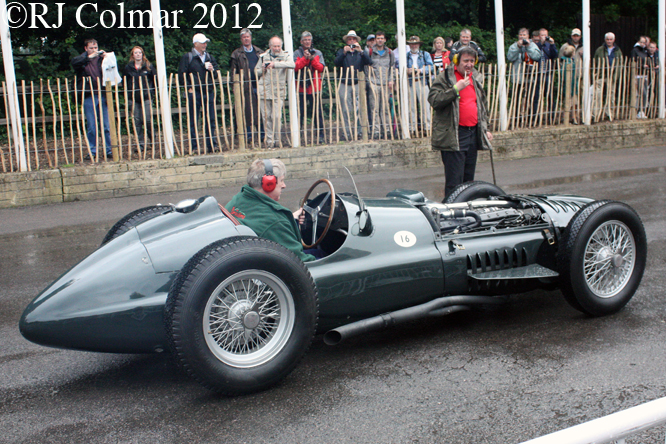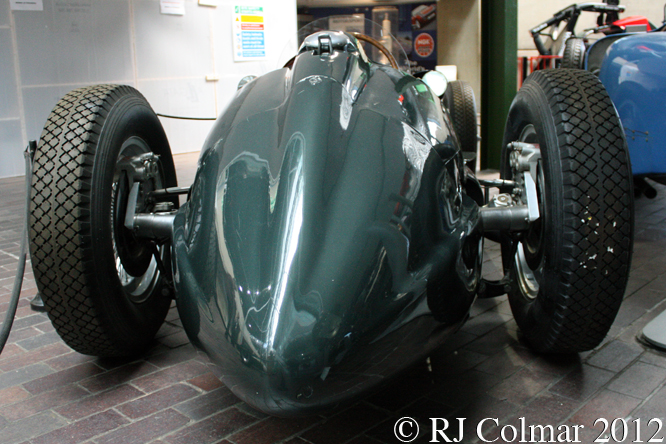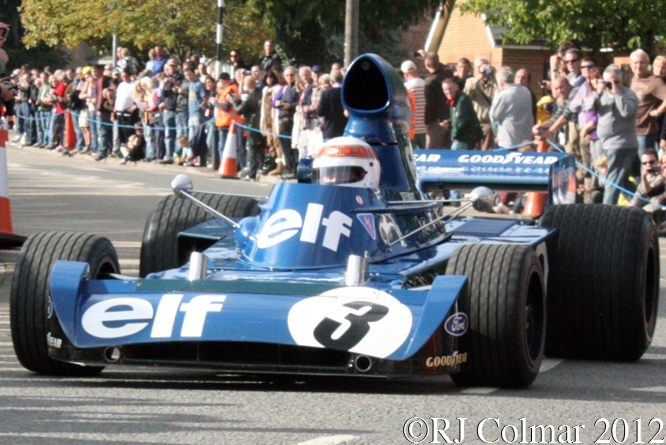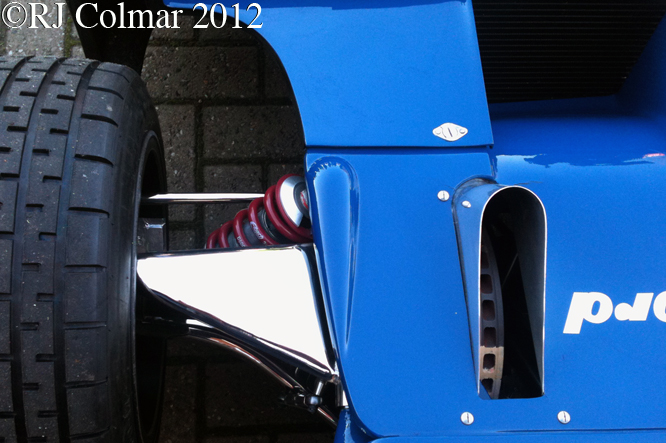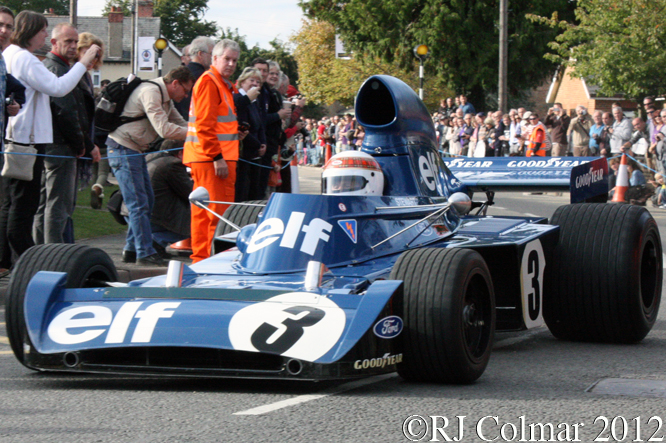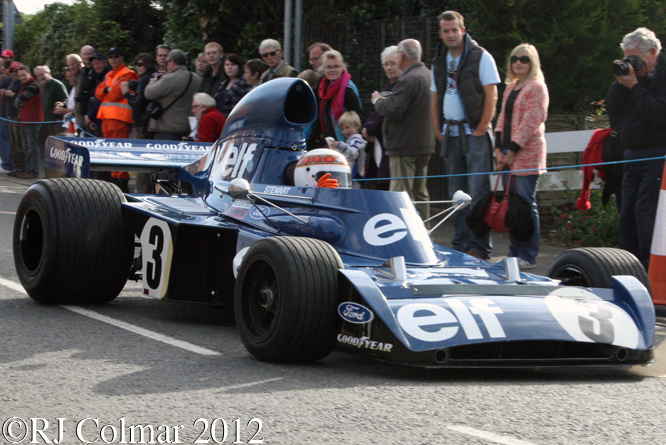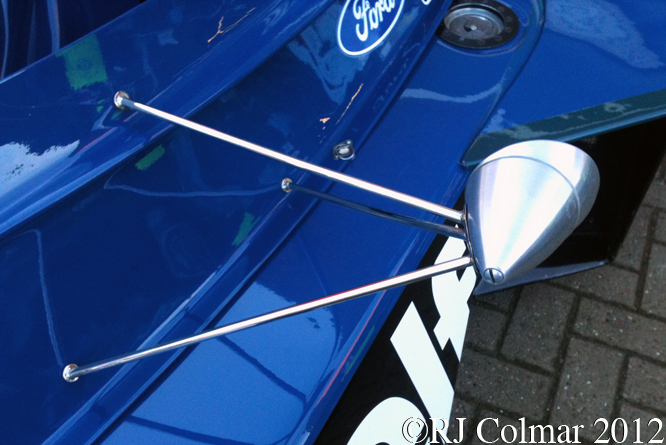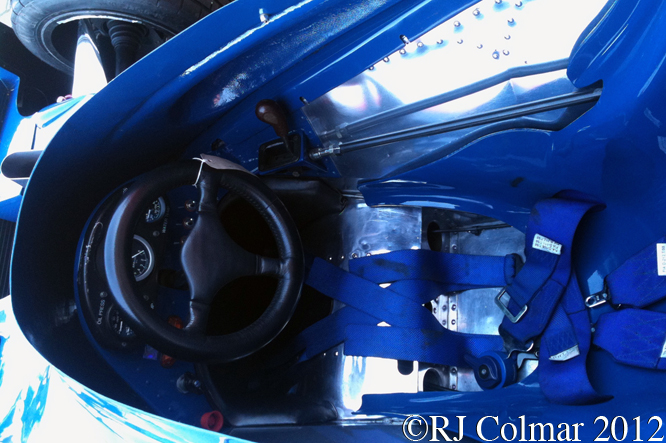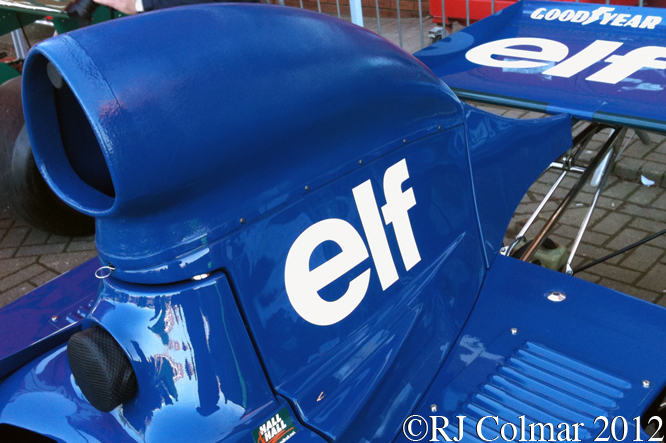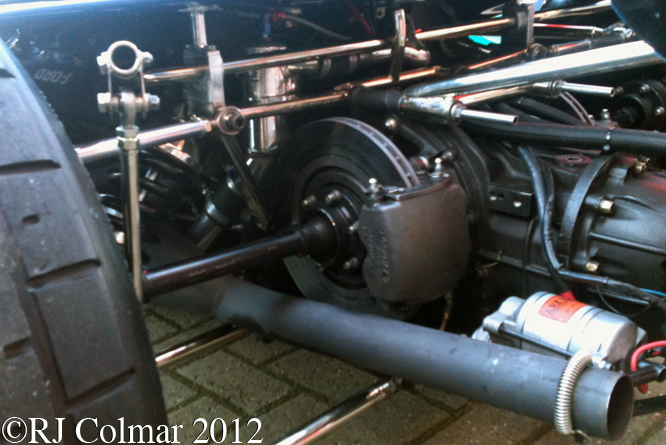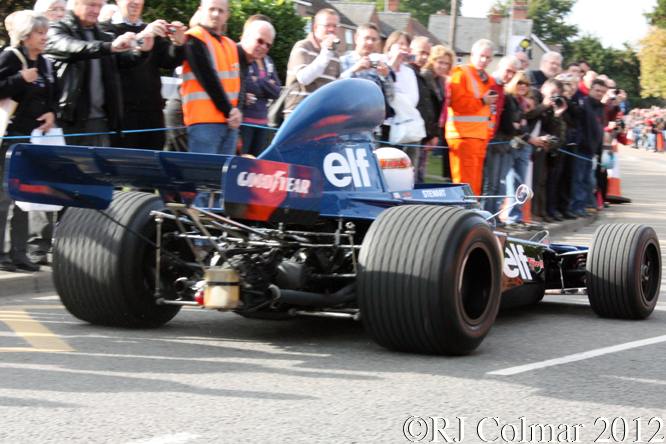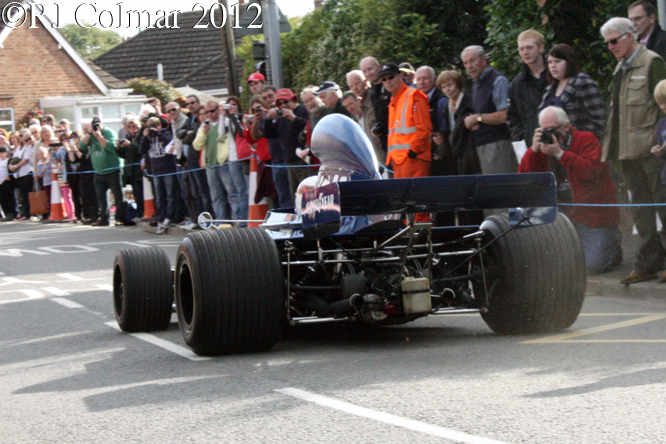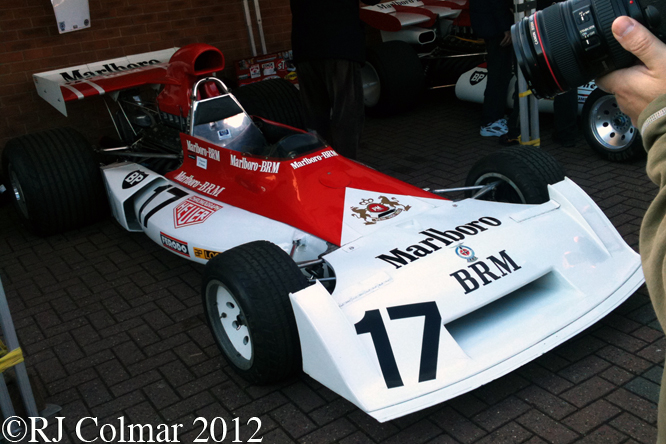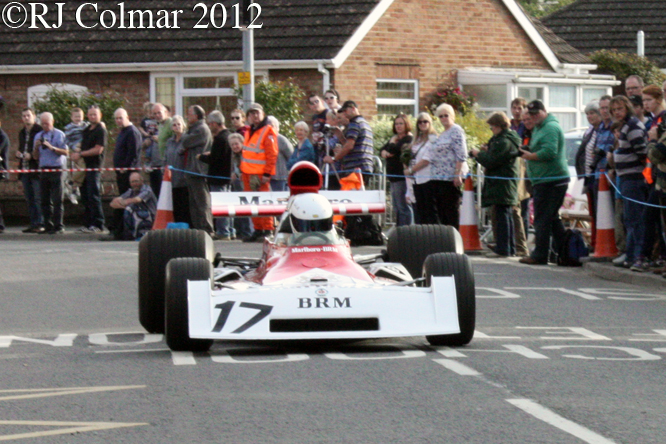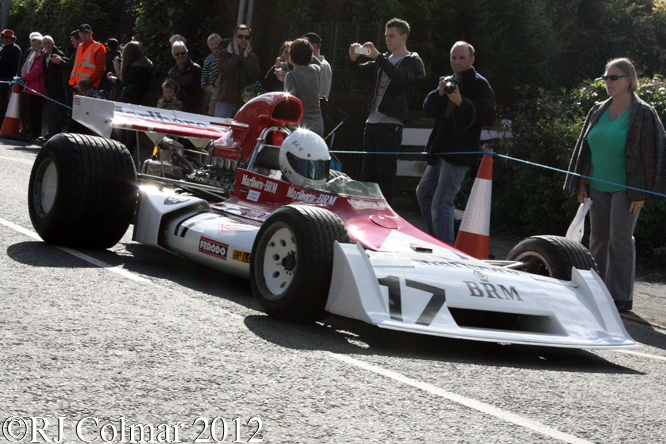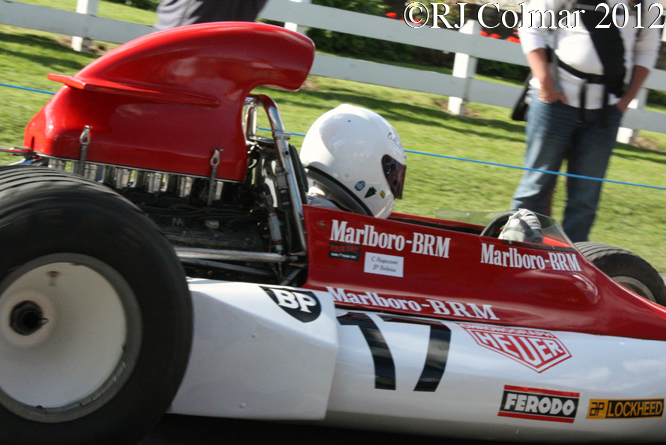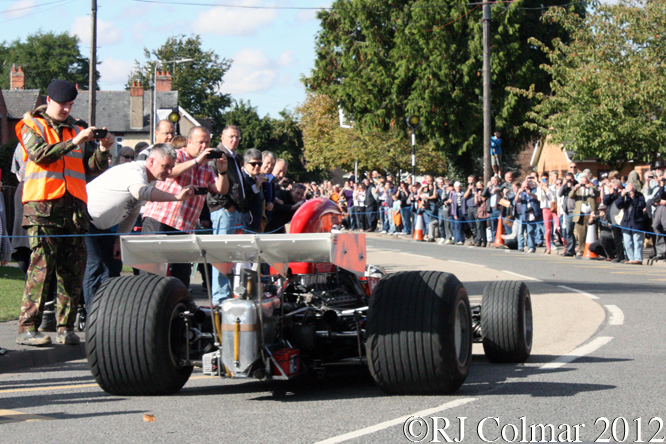A 3:30 am start on Sunday saw me head over to my friend Tim’s to the lilt of early morning Drum ‘n’ Bass on Radio One and then off to what turned out to be the hillier than expected climbs of Bourne, Lincolnshire, where BRM Day was to celebrate the 50th Anniversary of Graham Hills and BRM’s 1962 World Championship victories with a stupendous parade of motor vehicles.
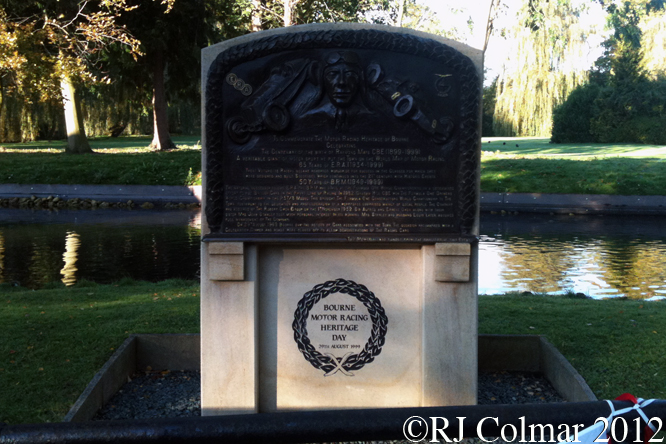
Bourne was the home of Raymand Mays, a well respected hill climber, who founded English Racing Automobiles, ERA, with Humphrey Cook, and Peter Berthon in Bourne in 1933 with the aim of “upholding British prestige in Continental European racing”. With the German Mercedes Benz and Auto Union teams given almost unlimited resources to operate in the top echelon of the sport ERA focused on the second tier Voiturette class of open wheel racing. After the ’39 / ’45 war Raymond May’s persuaded numerous parties in the automotive industry to join him in a new collaborative (ad)venture called British Racing Motors, BRM, which like ERA was based in Bourne. Above is a memorial to the 100th anniversary of the birth of Mays which was marked in 1999 with a similar event to last weekends BRM Day.
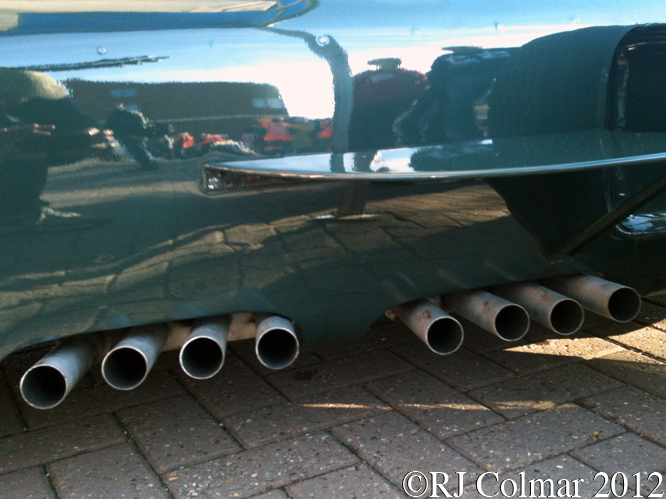
Before the start of the festivities I managed to wonder around the main paddock and to be honest I did not know where to look, there were so many storied cars on display. The Donington Collections 1954 BRM P30 Mark II was the second version of the 1.5 litre / 91.5 cui super charged V16 that had spectacularly failed an expectant nation in 1950. Back in those days these cars ran on strange mixtures of fuel that often included alcohol which meant the cars not only sounded great but smelt great too !
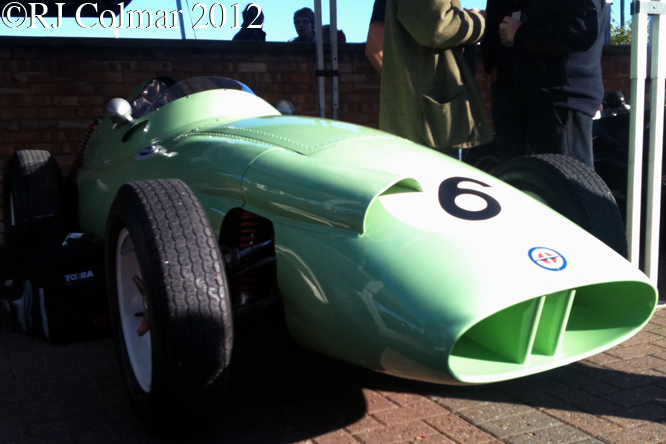
Among the cars that did not run was the British Racing Partnership teams 1959 BRM Type 25 chassis #25/10 which Stirling Moss drove to a second place finish in the 1959 British Grand Prix while taking a two race sojourn from Rob Walkers fast if unreliable Cooper T51. At the next race, the German Grand Prix at Avus, Hans Hermann drove this car and was captured falling out of it in some of the most spectacular motor racing photographs of all time.
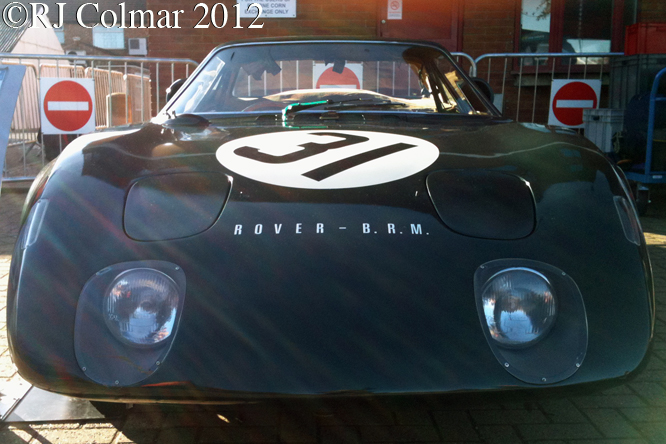
The Rover BRM Le Mans car started life as a BRM P57 Formula One car which Richie Ginther crashed at Monaco in 1962, when Rover and BRM discussed the idea of building a Rover gas turbine contender for Le Mans BRM rebuilt Ginthers wrecked car into a challenger for 1963 when it was driven to a 7th place finish by Ginther and Graham Hill. The car was subsequently rebodied for the 1965 race, as seen here when it finished in 10th place driven by Hill and Jackie Stewart. The gas turbine motor is being rebuilt and one day the car should be a runner again.
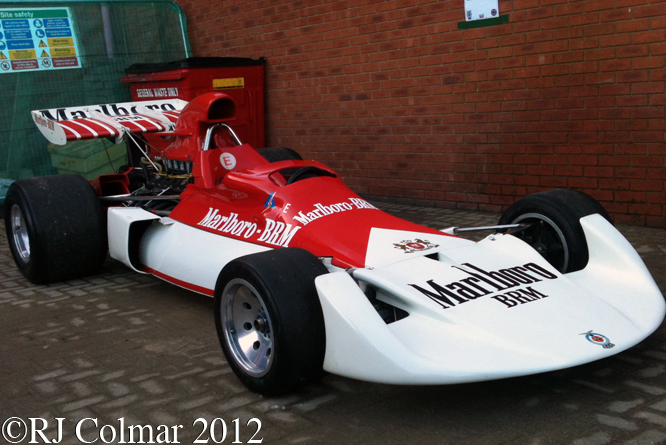
For 1972 BRM attracted a new sponsor Marlboro that wanted to follow the brand awareness lead set by the successful partnership of John Player and Lotus Cars which had netted two championships and many victories with the Lotus 49 and Lotus 72 models. In an act of supreme folly BRM announced it would run an A team of three drivers with two more forming a B team. The cars used would be a mixture of older P153’s dating back to 1970, P160’s first seen in 1971 and a third new for ’72 P 180 design as seen above that proved to be difficult to handle. JP Beltoise drove a P 180 at Brands Hatch for the last time in a non championship race at Brands Hatch in October 1972 where a wise tyre choice led to the cars one and only victory in it’s last ever race.
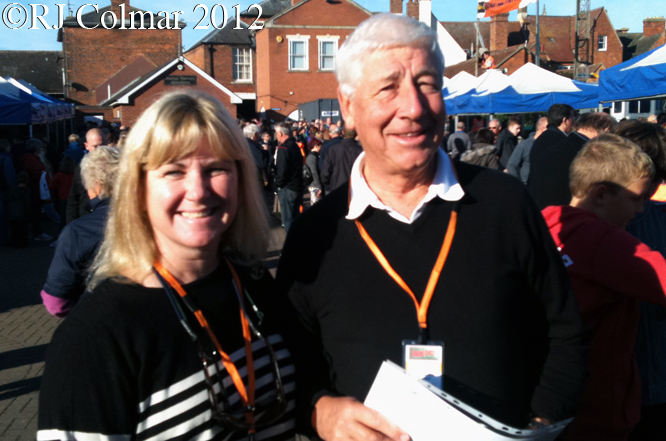
New Zealander Howden Ganley seen above with his step daughter Erin drove for BRM in 1971 and 1972, after his driving career came to an end in 1974 Howden joined forces with Australian Tim Schenken to form Tiga a highly successful manufacturer of racing cars for Formula Ford/Formula Ford 2000 and Sports 2000 before going on to build a successful run of Group C2 sports cars. Today Howden is President of Ancien Pilotes a group of retired drivers. Howden is allegedly trying to get his unfinished Formula One car from the 1970’s completed.
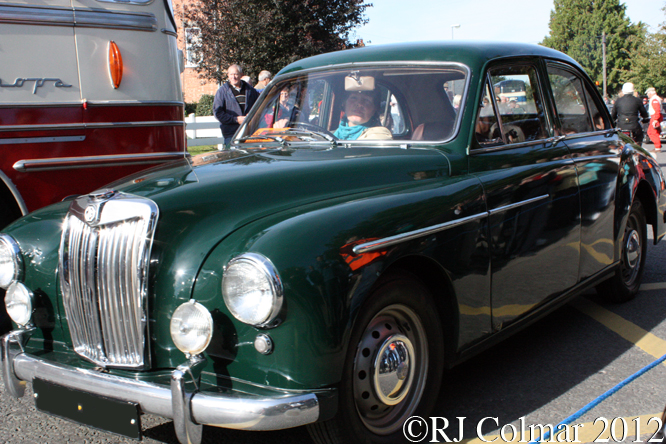
Tim and I found a nice spot to relax at the end of Abbey Road from which to watch the proceedings, we liked it so much we stayed there for the whole parade which started in the morning with a large number of pre 1962 vehicles of all sorts which nearly came to a stand still as an assortment of private and commercial vehicles negotiated the narrow roads. Above the owner of a 1958 MG ZB Magnette carefully negotiates the narrow gap between my toes and a big bus opposite me.
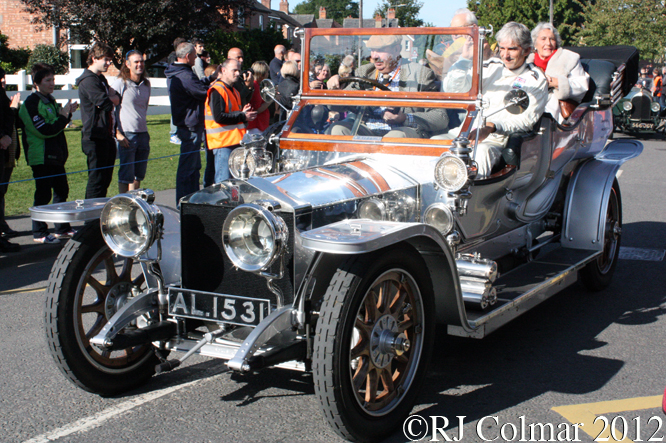
Guest family of honor at Bourne on Sunday naturally enough were the surviving Hills. Graham Hill’s widow Bette and son Damon, who followed his fathers career path to become 1996 World Drivers Champion are seen above on the passenger side of a 1910 Rolls Royce Silver Ghost.
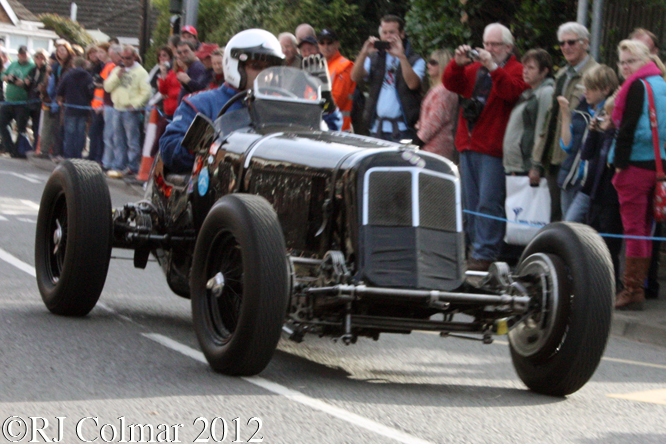
ERA 1B is the 5th ERA to be built, the first of the 2nd B series is seen above with Tim Cottam at the wheel. In 1935 the car was delivered new to Dick Seaman who impressed the ERA team so much they offered to prepare his car for him. Dick was not happy with the arrangement and eventually had the car prepared by Giulio Ramponi. Dick won races at Pescara, Italy, Berne, Switzerland and Brno, Czechoslovakia with R1B in 1935 before moving onto a Delage in 1936 and the works Mercedes Benz team in 1937.
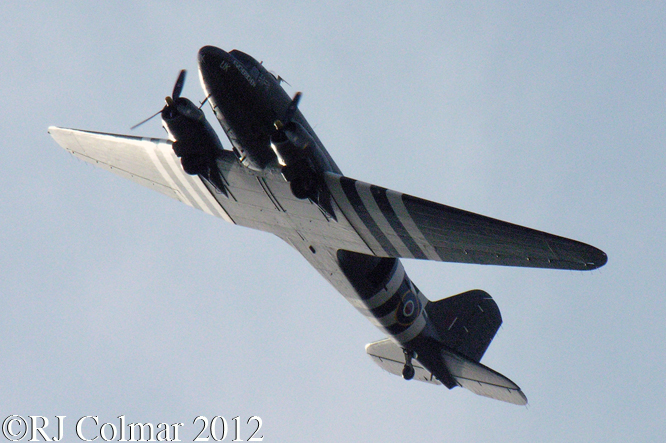
During the 1939/45 war Raymond Mays hatched his plan for BRM and ERA passed into the hands of Leslie Johnson who relocated ERA to Dunstable when the company reopened for business in 1947. Less than ten miles north of Bourne RAF Folkingham was commissioned to serve as a decoy airbase in 1940, it attracted at least three German bombing raids before being upgraded to operational status in 1943. In January 1944 the 313th Troop Carrier Group arrived with it’s Douglas C47’s which were used to land troops in Normandy as part of Operation Overlord in June 1944 and again to land paratroops in Arnhem in September 1944 as part of Operation Market Garden, which made the flyover of the C47 last Sunday particularly poingnant. BRM would use the base to test it’s vehicles in the 50’s and 60’s when it was not required as a missile base in the run up to the Cuban Missile Crisis of 1962.
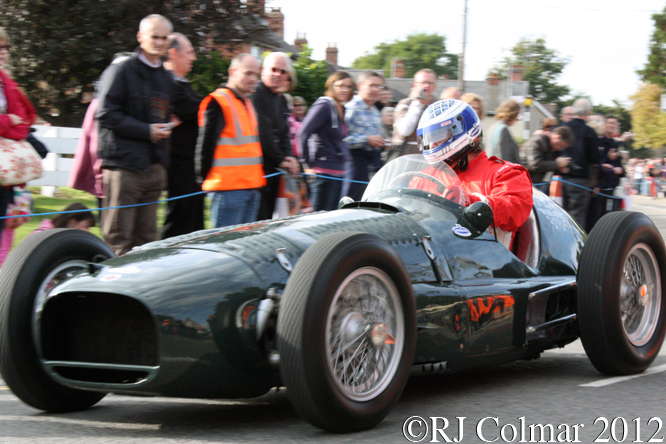
BRM’s first car the supercharged V16 Type 15 was a little on the recalcitrant side in the early days, but it was replaced by a shorter wheel base V16 P30 Mark II model in 1954 designed to take part in shorter non championship Formula One races. Kevin Wheatcroft is seen in the car above which I believe was used by Ken Wharton to win the five lap Chichester Cup at Goodwood first time out in April 1954. The sound and fumes from the 460 hp V16 at this range were thoroughly intoxicating !
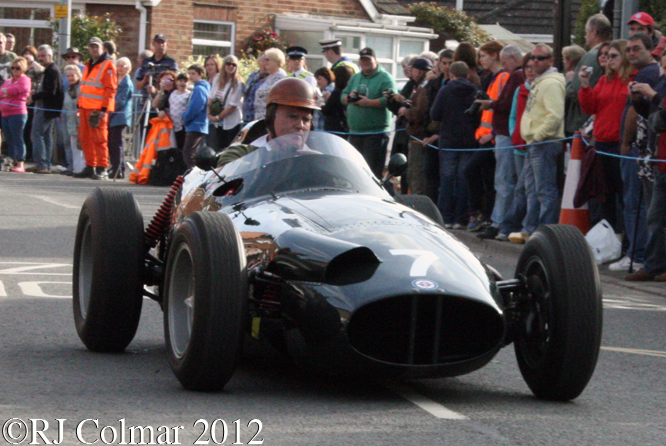
If the V16’s were a little on the complex side the 2.5 litre / 152 cui 4 cylinder Type 25’s were much simpler reflecting a change in management from BRM’s original Trust Committee’s to BRM’s new owner Sir Alfred Owen who purchased the Trust assets in 1953. John Pearson is seen here at the wheel of the 1958 chassis 258, which originally had 27/3 stamped on the chassis, for chassis Project 27 3rd of, which is the car that Jo Bonnier drove to victory in the 1959 Dutch Grand Prix ending 10 years of under achievement for the Bourne based operation. Spencer Flack who owned the car from 2001 was killed when driving it at Philip Island, Australia in 2003. His widow insisted the car which had split in two and caught fire be rebuilt by Hall & Hall the respected restoration experts who are based in Bourne.
As an aside BRM chassis type and project numbers do not follow any particular numerical sequence for example the first five Type 25’s were given chassis numbers #251 – #255 the remaining cars with slightly different chassis construction were given chassis numbers 27/1 to 27/6, P27 was the project number given to both chassis variations of the the Type 25 cars while project number P25 was given to the 2.5 litre / 152 cui 4 cylinder motors for the Type 25 BRM’s. To further confuse the matter the later cars with the 27/1 to 27/6 numbers stamped on the chassis were referred to as continuations of the earlier 251 – 255 numbering system hence chassis 27/3 is ALSO known as 258 @-)
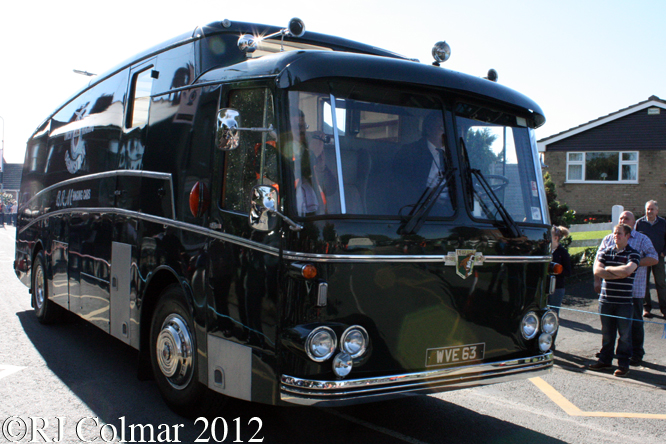
For 1960 BRM got a new transporter based on a Leyland Royal Tiger Worldwide bus chassis, notice the vehicle is left hand drive in anticipation of it mostly being used to transport racing cars across Europe rather than around the United Kingdom which was, still is and probably always will remain a country that drives on the left hand side of the road.
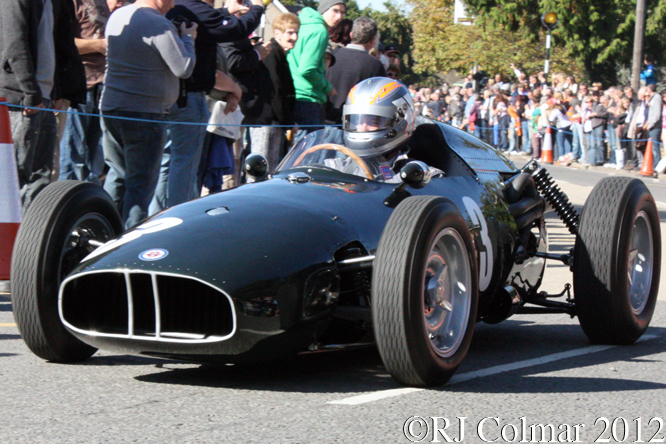
Rick Hall was instrumental in the organisation of last Sunday’s BRM Day his son Rob is seen above driving the P48 Mk I which belongs to Bruce McCaw of Seattle. This car was originally driven by Graham Hill and Dan Gurney in 1960/61, it started life as a front engined Type 25 chassis 27/2 ALSO known as 257 and was converted to P48/2, the second rear engined BRM, for the 1960 season When Graham Hill and Dan Gurney drive it.
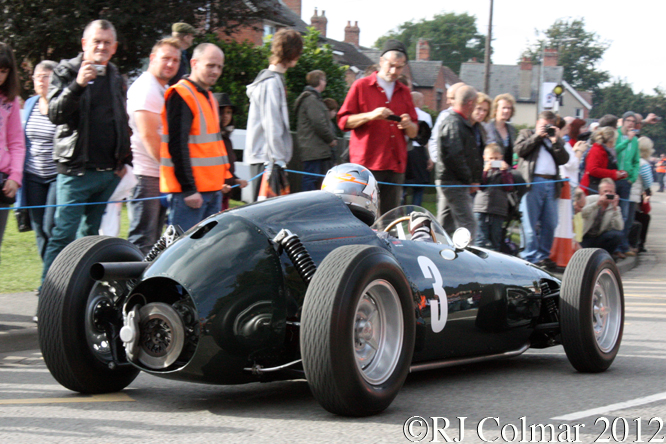
As on the Type 25 the P48’s rear brake was a single disc attached to the back of the rear transaxle which acted on both rear wheels while saving on all up and unsprung weight of the car to the benefit of the handling. The P48’s were not particularly successful in 1960 recording many retirements and a best 3 rd place for Graham Hill. In the winter of 1960/61 two P48’s were sent to Australia for Hill and Gurney to drive and Gurney won his last race in a BRM at Ballarat, but only after his car had been crashed the night before the race by some hooligans !
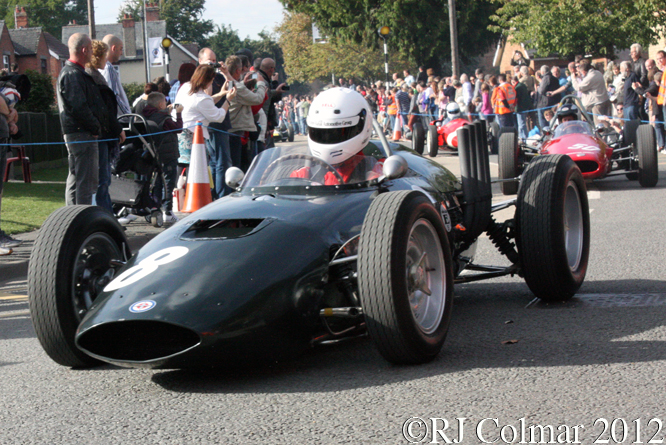
New Formula One regulations were introduced for 1961 requiring 1.5 litre / 91.5 cui motors. BRM started the season with proprietary Coventry Climax four cylinders before switching to their own V8’s which proved to be real gems. Initially the V8’s were fitted with stacked exhausts, but despite making a great howling noise they had a propensity to fall of and were replaced with conventional horizontal exhausts in 1962. Above the stacked exhausts on BRM P57 #57/3 are clearly visible. This car was driven by Graham Hill and Tony Brooks for the works while multiple British Hill Climb Champion Tony Marsh privately entered it into four non championship events before returning it to Bourne.
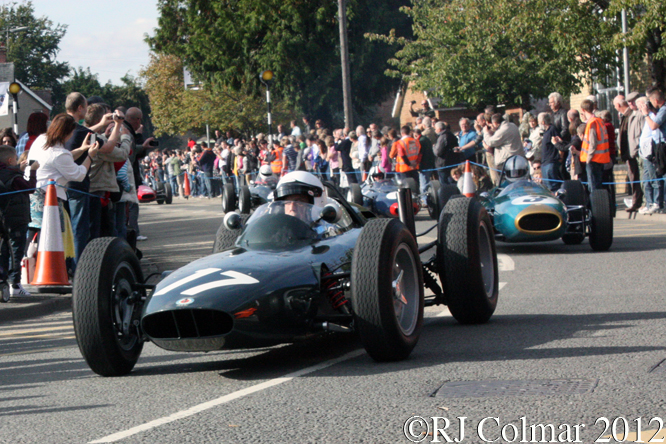
For 1962 the BRM teams new P57’s were numbered P578’s built to accept only the BRM V8 having the digit 8 added to the P57 project number. Graham Hill drove these cars to championship race victories in the Dutch, German, Italian and South African Grand Prix and clinched his first and BRM’s only World Championship’s. Above is P578 #578/2 in early 1962 spec with stacked exhaust pipes.

P578 #578/1 also known as ‘Old Faithful’ with the late ’62 horizontal exhausts was kindly sent over from the Collier Collection in Florida for Grahams son Damon Hill who can be seen at the wheel above.
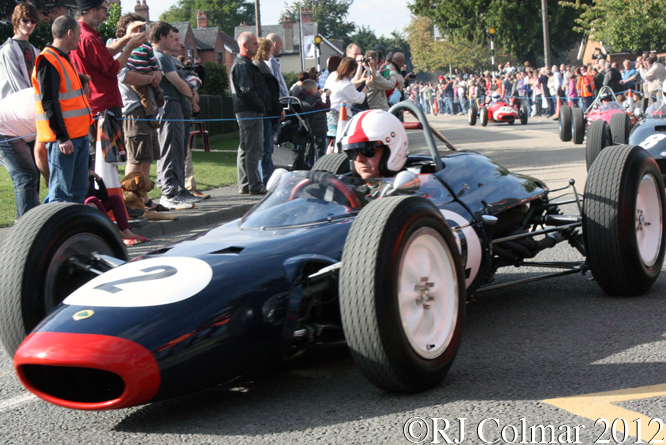
Such was the demand for 1.5 litre / 91.5 cui Formula One motors BRM had no trouble selling copies of their motor for privateers to use from 1962 onwards. Above Nigel Williams is at the wheel of the Parnell Team 1963 Lotus BRM 24, chassis #P1, fitted with Lola Mk 4A bodywork as raced by Peter Revson in the 1964 British Grand Prix from which he retired.
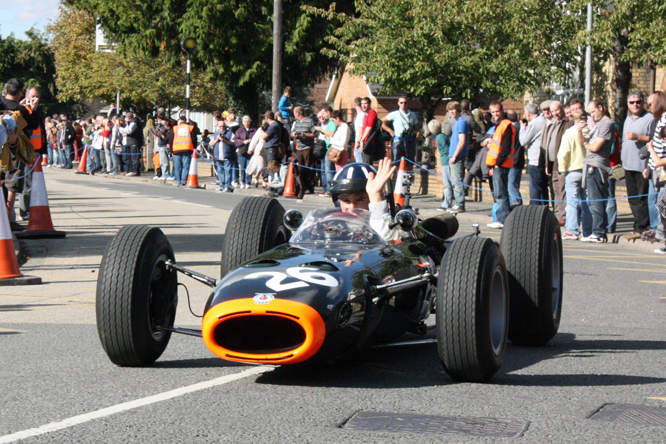
Graham Hill went into the last race of the 1964 season as leader of the World Championship 5 points ahead of Surtees in his Ferrari and 9 points ahead of reigning champion Jim Clark in his Lotus. During the Mexican Grand Prix the final race Hill was knocked out of contention by Surtees team mate Lorenzo Bandini, Clark led the race comfortably, a win would have handed Clark the championship on a more race wins tie breaker, until the last lap when an oil leak caused his Climax V8 to seize. Going into the last lap Surtees was lying third behind Bandini and eventual winner Dan Guerney. Fortunately Surtees team mate, Bandini, let Big John pass and claim six points for his second place finish enough to claim the championship from Hill by a single point. Above Damon Hill is seen at the wheel of a 1964 BRM P261 #P2615. The 2 stems from Mark 2 of the 1961 P61 chassis to give P261 !
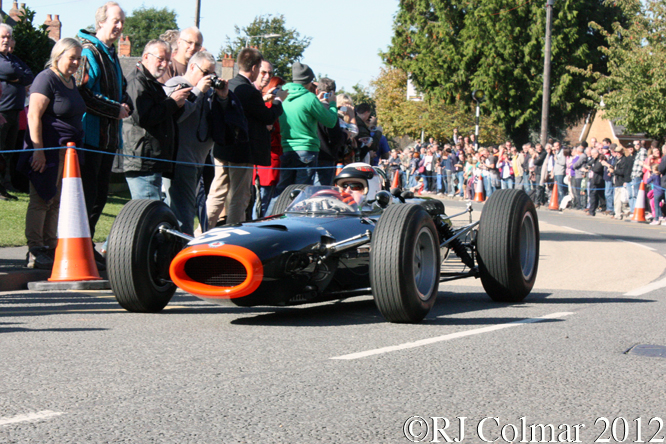
In 1965 rookie Jackie Stewart was signed up to partner Graham Hill at BRM and he did not disappoint, scoring three seconds and a win at the 1965 Italian Grand Prix to finish third in the championship behind Jim Clark and Graham Hill who finished second in the championship for the second year in a row. Sir Jackie is seen above driving #P2617 one of the cars he raced in the 1965 season.
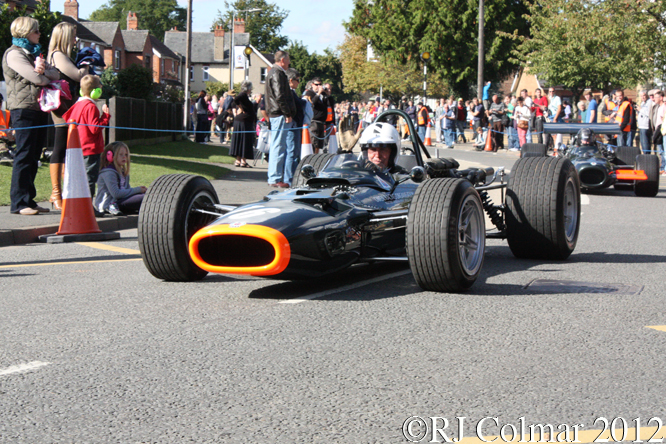
For 1966 the Formula One regulations changed mandating 3 litre / 183 cui motors, BRM initially ran 2 litre / 122 cui versions of the P261 cars before introducing a hideously complex 3 litre H16 which produced plenty of power and probably the best noise ever heard at any race track but was predictably unreliable. Unfortunately none of the BRM H16’s are running at the moment and a Lotus 43 fitted with one is also presently hors d’combat. So the BRM Parade skipped to 1968 when a parallel 3 litre V12 engine programme came on stream to power the one off BRM P126 seen above with Richard Attward at the wheel. Richard scored the cars best result a second place finish at Monaco in 1968.
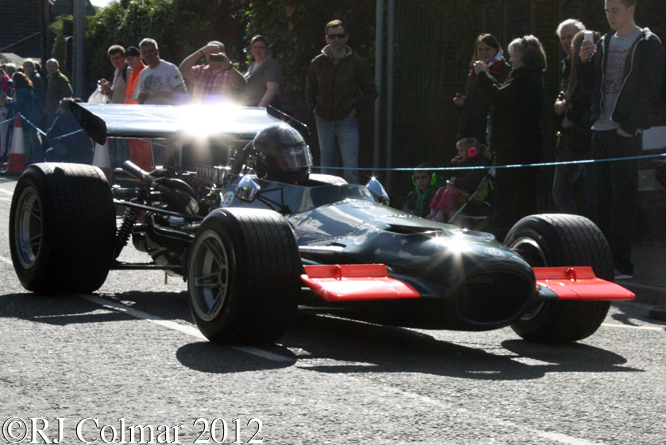
For 1969 John Surtees and Jackie Oliver were employed to drive for the BRM team which introduced the V12 powered P139 half way through the season. John scored the cars best result a 3rd place finish at the 1969 US Grand Prix.
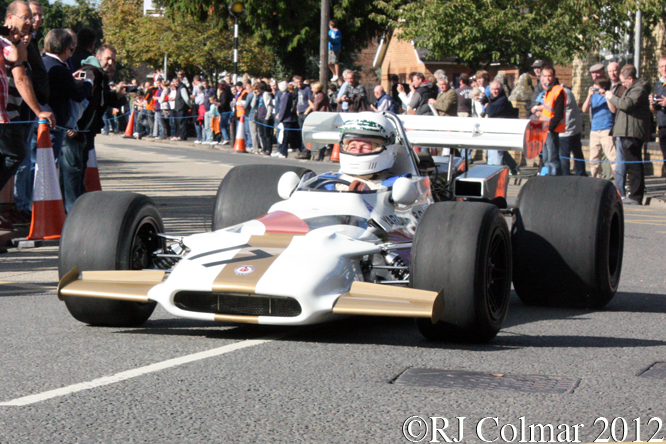
For 1970 Jackie Oliver was joined by Pedro Rodriguez at the now Yardley sponsored BRM and it was Pedro who scored the teams only win of the season with the BRM P153. For 1971 Howden Ganley, who is seen at the wheel of #153/4 here, joined the team which included a roster of a total of eight drivers.
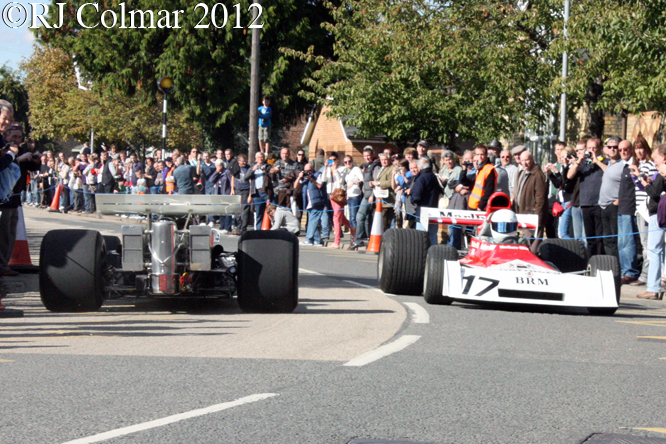
The P160 replaced the P153 part way through 1971 and Peter Gethin used one to win the close fought 1971 Italian Grand Prix. In 1972 Marlboro replaced Yardley as the teams sponsor and Jean Pierre Beltoise scored the BRM teams final championship victory at Monaco in 1972. Above the 1973 spec P160 chassis P160/7 of J Burt has an interesting moment as he passes S Burt in the older P153, luckily neither driver was on the racing line at the time.
Another little aside, in 1973 I attended the non championship Race of Champions at Brands Hatch, the first time I ever saw Formula One cars in action, the BRM P160’s of Beltoise, Niki Lauda and Vern Schuppan qualified 1st to 3rd on the grid. Amazingly Beltoise, Lauda and Ronnie Peterson driving a Lotus 72, were credited with fastest lap of the race at 1.23 secs dead. Of the three only Beltoise finished in a distant 6th place.
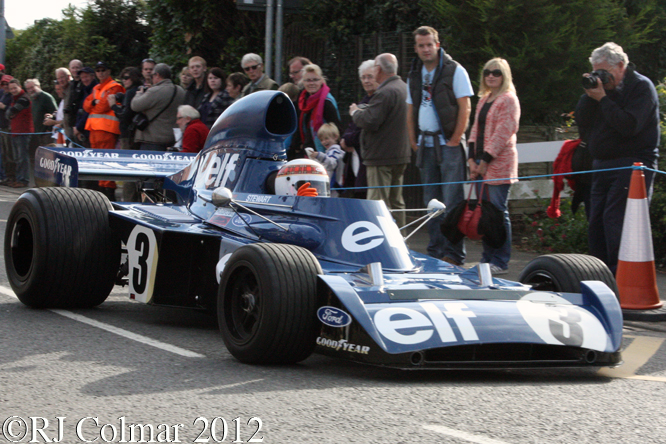
In 1973 BRM old boy Jackie Stewart won his third and final World Championship driving for the Tyrrell team, it was a real treat to see Sir Jackie driving a 1973 006 model through the streets of Bourne, not quite the Monaco Grand Prix, but without the crash barriers and safety fences of the Principalities street circuit, no less exciting.
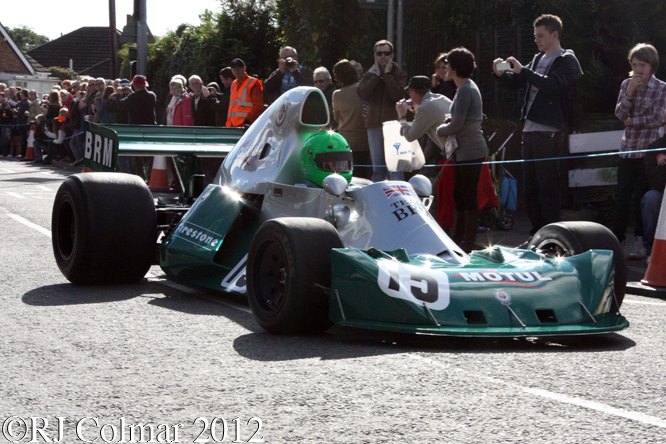
Probably my favorite BRM of all time is the P201 designed by Mike Pilbeam, featuring the 48 valve version of the V12 launched in 1968 the car appeared with sponsorship from Motul in 1974 when the team employed Beltoise, Le Mans Winner Henri Pescarolo and former Connew refugee Francois Migault at the wheel with Chris Amon drafted in to replace Pescarolo at the last two races of the year. The P201’s best result was a second place finish on its debut in South Africa with Beltoise at the wheel. Sir Alfred Owen passed away in 1974 and former team manager and Owen’s son in law Louis Stanley took over the team renaming it Stanley BRM in 1975. With no sponsorship to speak of, an out of date car and uncompetitive motor the team spiraled into a terminal decline the P207 was introduced in 1977 but started only one race in the hands of Larry Perkins. Perkins made BRM’s last Grand Prix start in South Africa this time with a much modified and hopelessly out dated P201. He finished 15th and there after Teddy Pilette, Conny Anderson and Guy Edwards all tried their hand at qualifying the P207 with out any success. J Fenning wearing a helmet just like the won worn by Henri Pescarolo is seen at the wheel of #P201/5 here, a car that was driven in the 1975 season under the Stanley-BRM banner by Bob Evans who’s best result was a 6th place finish in the non championship Race of Champions at Brands Hatch.
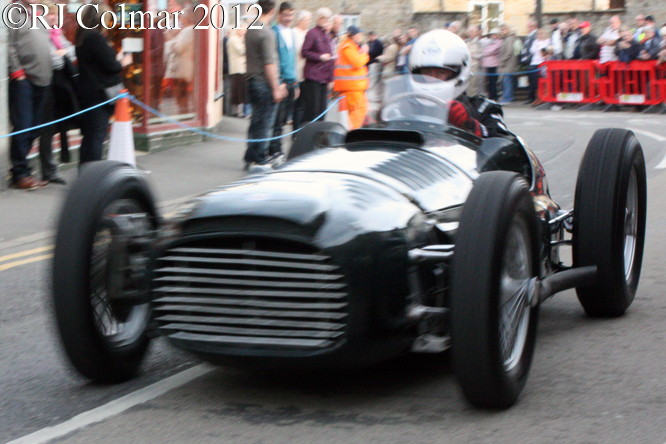
As the parade came to a conclusion the V16’s were given a second run, the sound of the very first V16 P15 driven by the National Motor Museums Doug Hill still reverberates round my head as I bring this “Pride In Bourne” edition of “Gettin’ a li’l psycho on tyres” to a close.
My thanks to everyone involved in organising and putting on this magnificent event which is without doubt the highlight of my motoring year.
On this link you will find a short film of the days activity that I have made.
Thanks for help with identifying the cars to The Nostalgia Forum in particular Tim Murray an Doug Nye. If you spot any errors please accept my apologies and chime in below with any corrections.
Thanks for joining me, I hope you will join me again tomorrow. Don’t forget to come back now !
